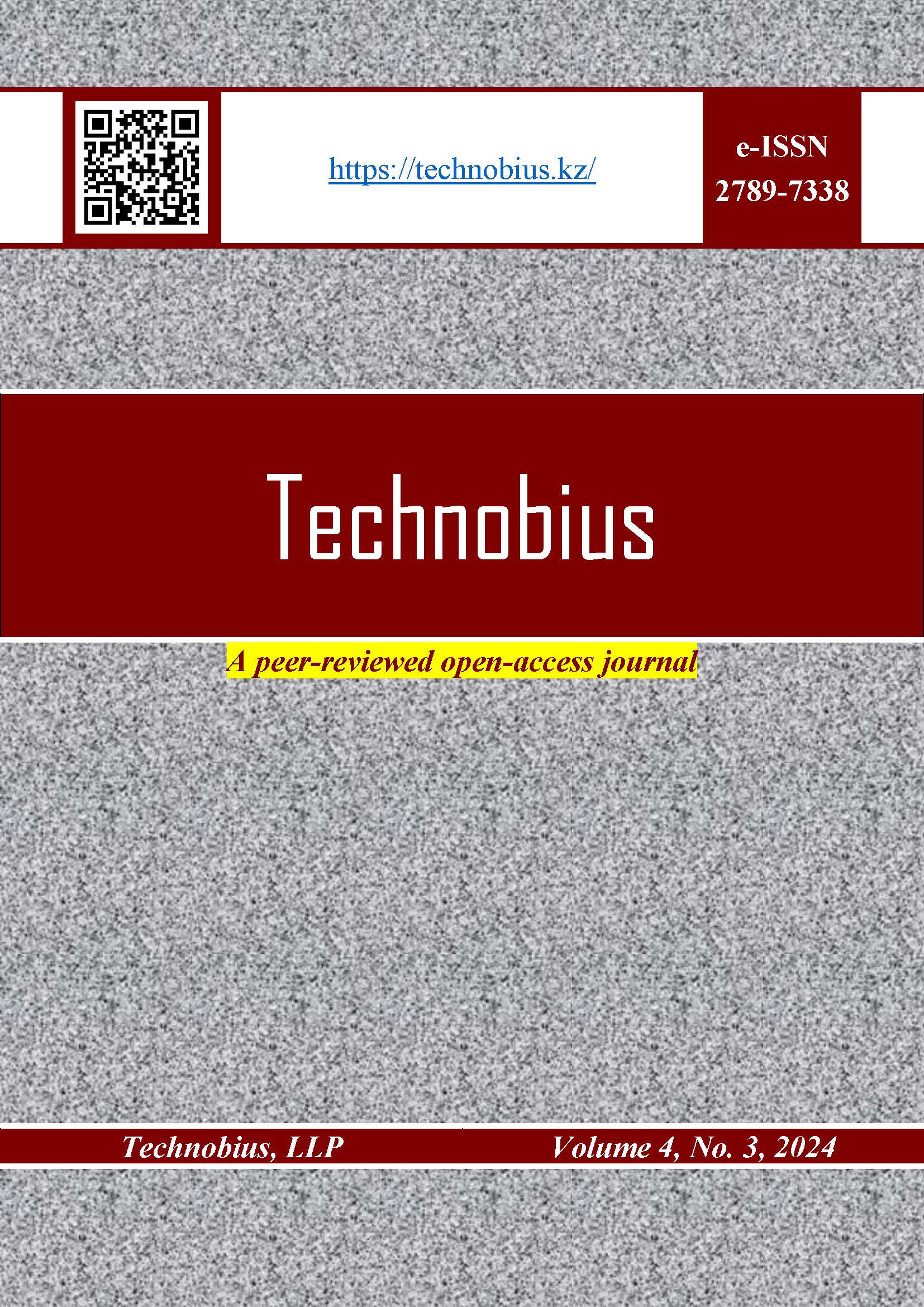Concretes based on technogenic wastes formed during the mechanical processing of carbonate rocks
DOI:
https://doi.org/10.54355/tbus/4.3.2024.0061Keywords:
waste, carbonate rocks, concrete, fillers, physical and mechanical properties of concreteAbstract
This article considers the possibility of using technogenic waste from the mechanical processing of Sastobe carbonate rocks as coarse and fine aggregates in the production of heavy concrete. X-ray diffractometric analysis CaCO3 d = (3.849-3.14-2.49-2.277-2.088-1.912-1.869 A0) and the endothermic peak in the temperature interval of 800-850°C in the differential-thermal analysis curve technogenic residues formed during mechanical processing of Sastobe carbonate rocks showed that it mainly consists of calcium carbonate. Studies have shown that fine and coarse aggregates based on carbonate rocks have a rough surface, which increases their specific surface area and ensures a strong bond with the cement stone. At the same time, technogenic waste contains 2-3% powder fraction up to 0.16 mm, this fraction serves as an active mineral mixture. As a result of research, the use of these wastes as fillers can reduce the consumption of traditional crushed stone and sand by 50% without reducing the physical and mechanical properties of concrete, replacing 50% of traditional fillers with technogenic fillers based on carbonate rocks, increasing the density of concrete (2490kg/m3), reducing its water absorption (0.66 %), strength (49.8 MPa) and frost resistance (F400) indicators made it possible to obtain concrete that is the same as the control sample and to reduce its cost without reducing the physical and mechanical properties of concrete and to improve the environmental conditions of the region.
Downloads
Metrics
References
Adilet.kz, “O Koncepcii perehoda Respubliki Kazahstan k ustojchivomu razvitiyu na 2007-2024 gody.” Accessed: Sep. 13, 2024. [Online]. Available: https://adilet.zan.kz/rus/docs/U060000216 _
B. T. Taimasov, N. N. Zhanikulov, and A. R. Kaltai, “Mineralno-syrevye istochniki dlya energosberegayushego proizvodstva portlandcementnogo klinkera,” Complex use of mineral resources, no. 2, pp. 95–101, 2016.
MEMR RK, “Metodicheskoe rukovodstvo po izucheniyu i ocenke tehnogennyh mineralnyh obektov, predstavlyaemyh na gosudarstvennuyu ekspertizu nedr.” Accessed: Sep. 13, 2024. [Online]. Available: https://online.zakon.kz/Document/?doc_id=31371775&pos=3;-108#pos=3;-108
New Times.kz, “«Bomba zamedlennogo dejstviya»: Kazahstan nakopil bolee 32 mlrd tonn musora.” Accessed: Sep. 13, 2024. [Online]. Available: https://newtimes.kz/obshchestvo/140999-bomba-zamedlennogo-deistviia-kazakhstan-nakopil-bolee-32-mlrd-tonn-musora
V. K. Kokunko, “Sozdanije i razvitije syrevoj bazy stroitelnyh materialov na osnove poputnodobyvaemyh porod i othodov gorno-rudnyh predpriyatij,” Stroitelnye materialy, no. 4, pp. 4–6, 1994.
N. Sarsenbaev et al., “Influence of additives of barium-carbonate tailing wastes on the properties of compositional binders and concretes,” Bulletin of Belgorod State Technological University named after. V. G. Shukhov, vol. 4, no. 4, pp. 24–31, Apr. 2019, doi: 10.34031/article_5cb1e6606f9c29.67138287. DOI: https://doi.org/10.34031/article_5cb1e6606f9c29.67138287
I. I. Kosinova and M. G. Zaridze, “Geoindikatory preobrazovaniya gruntov zony aeracii v rajonah infrastruktury po dobyche i pererabotke karbonatnogo syrya,” in Perspektivy razvitiya inzhenernyh izyskanij v stroitelstve v Rossijskoj Federacii : OAO “PNIIIS” - 50 let : materialy 9-j obsherossijskoj konferencii izyskatelskih organizacij, 28-29 noyab. 2013 g., Moscow: OAO “PNIIIS,” 2013, pp. 174–176.
R. Z. Rahimov, U. H. Magdeev, and V. N. Yarmakovskij, “Ekologiya, nauchnye dostizheniya i innovacii v proizvodstve stroitelnyh materialov na osnove i s primeneniem tehnogennogo syrya,” Stroitelnye materialy, no. 12, pp. 8–11, 2009.
B. K. Sarsenbaev, “Tehnologiya proizvodstva shlakoshelochnyh vyazhushih, betonov i izdelij : material tehnicheskoj informacii,” Novosti nauki Kazahstana, pp. 95–99, 2004.
G. V. Calder and T. D. Stark, “Aluminum Reactions and Problems in Municipal Solid Waste Landfills,” Practice Periodical of Hazardous, Toxic, and Radioactive Waste Management, vol. 14, no. 4, pp. 258–265, Oct. 2010, doi: 10.1061/(ASCE)HZ.1944-8376.0000045. DOI: https://doi.org/10.1061/(ASCE)HZ.1944-8376.0000045
V. S. Demyanova, V. M. Trostyanskij, and O. A. Chumakova, “Ekologicheskie aspekty resursosberezheniya nerudnyh poleznyh iskopaemyh,” Uspehi sovremennogo estestvoznaniya, no. 8, pp. 91–93, 2008.
N. A. Suzev, T. M. Hudyakova, and S. A. Nekipelov, “Nekotorye svojstva betonov na karbonatnom portlandcemente,” Tehnologii betonov, no. 9–10, pp. 20–22, 2009.
A. U. Shayahmetov, A. G. Mustafin, and I. A. Massalimov, “Osobennosti termicheskogo razlozheniya oksida, peroksida, gidroksida i karbonata kalciya,” Vestnik Bashkirskogo universiteta, vol. 16, no. 1, pp. 29–32, 2011.
G. G. Islamova, T. Z. Lygina, and A. M. Gubajdullina, “Kinetika tverdofaznogo sinteza silikatov kalciya i kachestvennaya diagnostika produktov sinteza,” Vestnik Kazanskogo tehnologicheskogo universiteta, no. 8, pp. 257–262, 2010.
R. Arora et al., “Potential utilization of waste materials for the production of green concrete: A review,” Mater Today Proc, vol. 69, pp. 317–322, 2022, doi: 10.1016/j.matpr.2022.08.542. DOI: https://doi.org/10.1016/j.matpr.2022.08.542
O. V. Kononova and V. D. Cherepov, “Carbonate rocks crushing screenings based artificial stone structure formation,” Fundamental Research, no. 9, pp. 1200–1204, 2014.
O. V. Kononova, V. D. Cherepov, and N. A. Ivanov, “Polimercementnye kompozicii na osnove karbonatnyh porod,” in Materialy Vserossijskoj mezhdisciplinarnoj nauchnoj konferencii «Chetyrnadcatye Vavilovskie chteniya. Rossiya v globalnom mire: vyzovy i perspektivy razvitiya», Yoshkar-Ola, 2011, pp. 175–178.
A. E. Shejkin, Yu. V. Chehovskij, and M. I. Brusser, Struktura i svojstva cementnyh betonov. Moscow: Strojizdat, 1979.
Downloads
Published
How to Cite
License
Copyright (c) 2024 Raushan Nurymbetova, Rayimberdy Ristavletov, Nikolay Suzev, Elmira Kalshabekova, Ruslan Kudabayev

This work is licensed under a Creative Commons Attribution-NonCommercial 4.0 International License.








